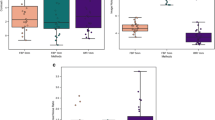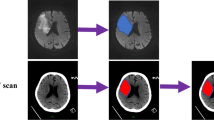Abstract
Purpose: Detection of early CT signs of infarct in non- enhanced CT image is mandatory in patients with acute ischemic stroke. Loss of the gray-white matter interface at the lentiform nucleus or the insular ribbon has been an important early CT sign of acute cerebral infarction, which affects decisions on thrombolytic therapy. However, its detection is difficult, since the principal early CT sign is subtle hypoattenuation. An image processing method to reduce local noise with edges preserved was developed to improve infarct detection.
Rationale: An adaptive partial median filter (APMF) was selected for this application, since the APMF can markedly improve the visibility of the normal gray-white matter interface. APMF should enhance the conspicuity of gray-white matter interface changes due to hypoattenuation that accompanies cerebral infarction.
Method: In a criterion referenced performance study using simulated CT images with gray-white matter interfaces, a total of 14 conventional smoothing filters were also used for comparison to validate the usefulness of the proposed APMF. The APMF indicated the highest performance among the compared methods. Then, observer performance study by receiver operator characteristic (ROC) analysis was performed with 4 radiologist observers using a database with 18 abnormal and 33 normal head CT images.
Results: The average A z values of ROC curves for all radiologists increased from 0.876 without the APMF images to 0.926 with the APMF images, and this difference was statistically significant (P = 0.04).
Conclusions: The results from the two observer performance studies demonstrated that APMF has significant potential to improve the diagnosis of acute cerebral infarction using non-enhanced CT images.
Similar content being viewed by others
References
The World Health Report (2002) World Health Organization, pp 186–191
Health and Welfare Statistics Association (2004) Journal of health and welfare statistics
Adams HP, Adams RJ Jr, Brott T, del Zoppo GJ, Furlan A and Goldstein LB (2003). Guidelines for the early management of patients with ischemic stroke: a scientific statement from the Stroke Council of the American Stroke Association. Stroke 34: 1056–1083
Adams H, Adams R, del Zoppo G and Goldstein LB (2005). Guidelines for the early management of patients with ischemic stroke: 2005 guidelines update a scientific statement from the Stroke Council of the American Heart Association/American Stroke Association. Stroke 36: 916–923
von Kummer R, Allen KL, Holle R, Bozzao L, Bastianello S and Manelfe C (1997). Acute stroke: usefulness of early CT findings before thrombolytic therapy. Radiology 205: 327–333
Wardlaw JM, Dorman PJ, Lewis SC and Sandercock PA (1999). Can stroke physicians and neuroradiologists identify signs of early cerebral infarction on CT?. J Neurol Neurosurg Psychiatry 67: 651–653
Barber PA, Demchuk AM, Zhang J and Buchan AM (2000). Validity and reliability of a quantitative computed tomography score in predicting outcome of hyperacute stroke before thrombolytic therapy. ASPECTS Study Group. Alberta Stroke Programme Early CT Score. Lancet 355: 1670–1674
Tomura N, Uemura K, Inugami A, Fujita H, Higano S and Shishido F (1988). Early CT finding in cerebral infarction: obscuration of the lentiform nucleus. Radiology 168: 463–467
Truwit CL, Barkovich AJ, Gean-Marton A, Hibri N and Norman D (1990). Loss of the insular ribbon: another early CT sign of acute middle cerebral artery infarction. Radiology 176: 801–806
Schriger DL, Kalafut M, Starkman S, Krueger M and Saver JL (1998). Cranial computed tomography interpretation in acute stroke: physician accuracy in determining eligibility for thrombolytic therapy. J Am Med Assoc 279: 1293–1297
Wardlaw JM and Mielke O (2005). Early signs of brain infarction at CT: observer reliability and outcome after thrombolytic treatment-systematic review. Radiology 235: 444–453
Kalender WA (2000). Computed tomography: fundamentals, system technology. image quality and applications. Publicis MCD, Munich
Kalra MK, Maher MM, Sahani DV, Blake MA, Hahn PF and Avinash GB (2003). Low-dose CT of the abdomen: evaluation of image improvement with use of noise reduction filters-pilot study. Radiology 228: 251–256
Kachelriess M, Watzke O and Kalender WA (2001). Generalized multi-dimensional adaptive filtering for conventional and spiral single-slice, multi-slice, and cone-beam CT. Med Phys 28: 475–490
Guis VH, Adel M, Rasigni M and Rasigni G (2003). Adaptive neighborhood contrast enhancement in mammographic phantom images. Opt Eng 42: 357–366
Tsai DY, Takahashi N, Lee Y (2005) An adaptive enhancement algorithm for CT brain images. In: Proceedings of the 2005 IEEE engineering in medicine and biology 27th annual conference :paper #124
Lee Y, Takahashi N, Tsai DY and Fujita H (2006). Detectability improvement of early sign of acute stroke on brain CT images using an adaptive partial smoothing filter. Proc SPIE Med Imaging 6144: 2138–2145
Russ JC (1995) The image processing handbook, 2nd edn. CRC, Boca Raton, pp 155–178
Tukey JW (1971). Exploratory data analysis. Addison Wesley, Reading
Davis LS and Rosenfeld A (1978). Noise cleaning by iterated local averaging. IEEE Trans Syst Man Cybern SMC- 8: 705–710
Wu WY, Wang MJJ and Liu CM (1992). Performance evaluation of some noise reduction methods. Comput Vis Graph Image Process 54: 134–146
Ehrich RW (1978). A symmetric hysteresis smoothing algorithm that preserves principal features. Comput Graph Image Process 8: 121–126
Lev A, Zucker SW and Rosenfeld A (1977). Iterative enhancement of noisy images. IEEE Trans Syst Man Cybern SMC- 7: 435–442
Wang DCC, Vagnucci AH and Li CC (1981). Gradient inverse weighted smoothing scheme and the evaluation of its performance. Comput Vis Graph Image Process 15: 167–181
Nagao M and Matuyama T (1978). Edge preserving smoothing. Comput Graph Image Process 9: 394–407
Zamperoni P (1990). Some adaptive rank order filters for image enhancement. Pattern Recognit Lett 11: 81–86
Xu X, Miller EL, Chen D and Sarhadi M (2004). Adaptive two-pass rank order filter to remove impulse noise in highly corrupted images. IEEE Trans Image Process 13(2): 238–247
Kuan DT, Sawchuk AA, Strand TC and Chavel P (1985). Adaptive noise smoothing filter for images with signal-dependant noise. IEEE Trans Pattern Anal Mach Intel 7(2): 165–177
Centeno JAA and Haertel V (1997). An adaptive image enhancement algorithm. Pattern Recognit 30(7): 1183–1189
Fischl B and Shwartz EL (1999). Adaptive nonlocal filtering: a fast alternative to anisotropic diffusion for image filtering. IEEE Trans Pattern Anal Mach Intel 21(1): 42–48
Westin CF, Richolt J, Moharir V and Kikinis R (2000). Affine adaptive filtering of CT data. Med Image Anal 4(2): 161–177
Schilham AMR, Ginneken BV, Gietema H and Prokop M (2006). Local noise weighted filtering for emphysema scoring of low-dose CT images. IEEE Trans Med Imaging 25(4): 451–463
Gijbels I, Lambert A and Qiu P (2006). Edge-preserving image denoising and estimation of discontinuous surfaces. IEEE Trans Pattern Anal Mach Intel 28(7): 1075–1087
Lev MH, Farkas J, Gemmete JJ, Hossain ST, Hunter GJ, Koroshetz WJ and Gonzalez RG (1999). Acute stroke: improved nonenhanced CT detection-benefits of soft-copy interpretation by using variable window width and center level settings. Radiology 213: 150–155
Dolfman DD, Berbaum KS and Metz CE (1992). ROC rating analysis: generalization to the population of readers and cases with the jackknife method. Invest Radiol 27: 723–731
Author information
Authors and Affiliations
Corresponding author
Rights and permissions
About this article
Cite this article
Lee, Y., Takahashi, N., Tsai, DY. et al. Adaptive partial median filter for early CT signs of acute cerebral infarction. Int J CARS 2, 105–115 (2007). https://doi.org/10.1007/s11548-007-0123-3
Received:
Accepted:
Published:
Issue Date:
DOI: https://doi.org/10.1007/s11548-007-0123-3




